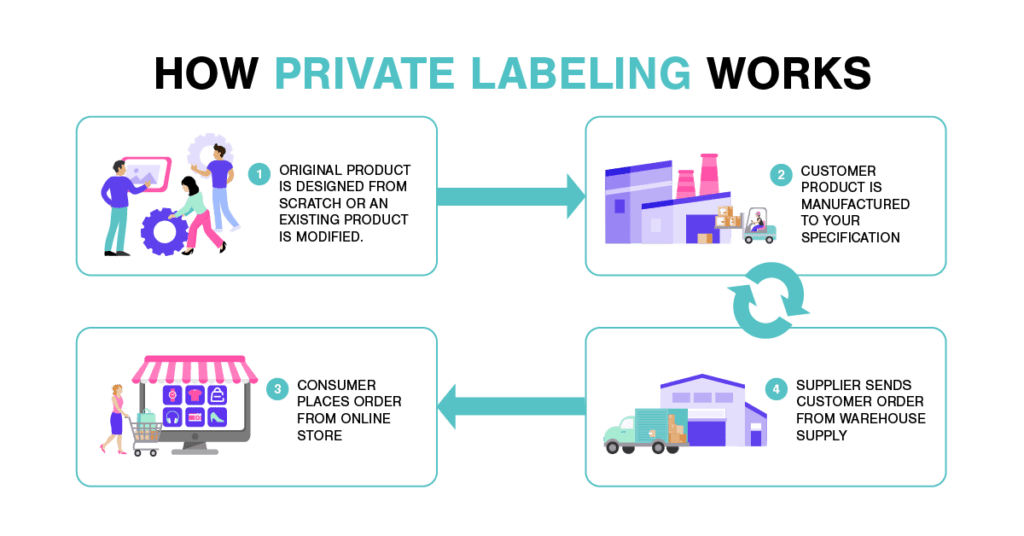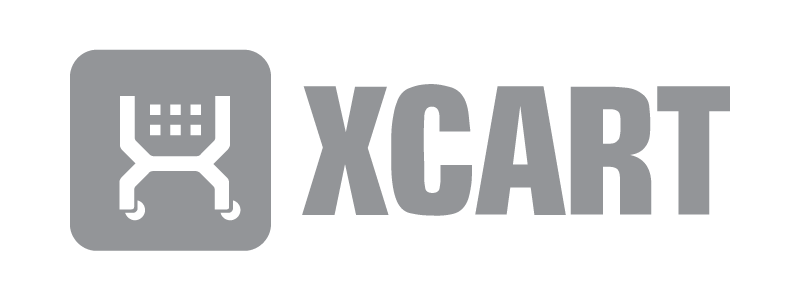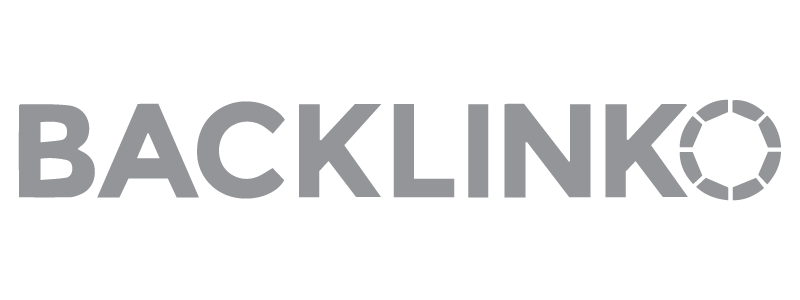How do I start an Amazon private label brand? Should I open an Amazon account in my country or America? Do I need an EIN or registered business address? Can I use Amazon FBA with private-label goods?
My subscribers send me questions like these all the time. There’s a lot of interest in how to start a private label Amazon FBA, but also a lot of confusion.
That’s why I wanted to answer everyone’s questions with an official post. 🙂
I’ve written before about how to start an ecommerce company from scratch, but not about a private label Amazon FBA specifically.

This article guides you through the early stages of the Amazon FBA private label business, along with what you need to know about FBA and my personal recommendation: Amazon MCF (Multi-Channel Fulfillment).
If you have any questions about Amazon private labels, this article should clear everything up.
What Is Private Label?
Let’s begin with the bare basics, in case you really are starting from scratch. Private labeling, to me, is taking a generic product, making it own by some type of modification, and then selling it under your own brand. (Compare this against “white labeling,” which is selling another manufacturer’s product as is.)

Because different brands can offer the same private label products, the key to success is what you add to the product, which could be a physical feature or superior marketing and customer relations. Your product quality is nearly identical to your competitors, so you have to rely on other sales techniques like branding, pricing, advertising, shopping experience, etc.
Private label selling has its advantages over traditional models, especially when it comes to profit margins. One of the key benefits is the ability to create and expand a unique product line, which can ultimately lead to higher profits. Smaller companies can cut production costs while they build up their brand name, while larger companies can use it to experiment safely in new markets. Think of how many clothing companies branch off into different product lines such as cosmetics or perfumes.
Likewise, private label products could be an upgrade in quality, or resolve some compliance issues. If you’re expanding internationally, it may be more effective to sell a local private label product that already complies with the country’s standards, rather than to alter your existing production process.
Research Better Products to Increase Sales
A private label company’s brand identity and reputation depend on the quality control of their products, making it crucial for brand owners to ensure high standards. That’s why your first step should be sharpening your product research skills. I’ve written a lot about product research before and I don’t want to retread any ground, so take a look at the links below to learn more.
First things first, you need to choose a profitable ecommerce business idea. What’s your niche? Where can you add value to the market? Once you have a niche, you need to know what to sell online to your followers, both trending products to capitalize on sales and evergreen sellers to stabilize your business.
Private label products have an additional set of criteria for what makes them worthwhile, particularly whether the demand is high enough and whether there’s room for improvement in marketing or on generic features. You can see my list of 29 private label product ideas to help inspire some avenues you can pursue.
If you’re here specifically for Amazon private label advice, you need to know what to sell on Amazon. If you have some budget to spare, you can also use Jungle Scout services to reveal new ideas for products and categories in your niche.
What Makes a Brandable Product?
By and large, as a private label seller, you want to sell products that you can make your own, at least in a branding sense. I’d strongly avoid retail arbitrage if you are serious about starting a private label brand. Making a successful private label business relies on choosing products that you can market according to your brand persona.
Some products are easier to market than others. Here’s what I recommend to my subscribers:
- Small products. They’re cheaper to store and ship for your manufacturer, so you can either pass the savings to your shoppers or profit from the markup.
- Lightweight products. Anything under 3 pounds.
- Priced between $15 and $50. That’s the sweet spot before consumers think twice about spending so much money.
- Products that trend on Google. For me, they need a minimum of 1,000 searches per month, but without too many competitors — if two or three small sites still rank on the first page, the “big fish” haven’t caught on yet, so add it to your store.
- Niche influencers are present. This is a sure sign that you can have a product niche you can build a brand around, especially if you offer your own private label products or branded products.

For Amazon FBA private label, you want to make sure there are over 5,000 searches on Amazon every month, but with only low or medium competition. You also want to make sure it’s a niche you understand: can you make a short list of popular influencers and bloggers off the top of your head?

Some entrepreneurs will tell you choosing a product is more about instinct, but I prefer empirical, black-and-white guidelines when deciding on a business model.
How to Find the Best Manufacturers for Sourcing Your Product
Just like you need to research the best products to sell, you also need to partner with manufacturers who you work well with. It’s more than just what products they offer. Are they prompt with deliveries? Do they offer the best prices? Are they legally compliant with the brand registry — you don’t want to get in trouble because you didn’t check their paperwork.

Alibaba is a great place to start your search for finding product ideas and, ultimately, source products from China. This post on finding a manufacturer for Amazon private label includes a free list of suppliers. Once you do find a short list of suppliers, make sure you get product samples before you do any bulk orders.
Step-by-Step Guide to Selling Private Label On The Amazon Marketplace
Despite its shortcomings, Amazon is a good equalizer for international vendors looking to expand their business worldwide. You can sell on Amazon from pretty much any country, with your only real obstacle just learning the ropes. Here’s how you can set up Amazon FBA in just 4 steps.
Step 1. Register
The first step is also the easiest: you just set up your account. Go to the Amazon FBA main page and click Get Started. If you don’t already have an Amazon seller account, you can create one now by clicking Register Now.

Just note that you will need multiple forms of identity verification, including a photo of your driver’s license and photos (not screenshots) of your bank account info.

If you’re already an Amazon retailer, click Add FBA to your account.
It also helps to create listings for all your products now, since you’ll need to do that before you send your first shipment to an FBA center anyway. How to make product listings for Amazon is a topic worth its own article, which we’ll get to another time.
Step 2. Preparing Inventory
The Amazon warehouse FBA program essentially stores and ships your Amazon Brand products for a fee through your Amazon listing. Dealing with an assortment of different vendors from different countries, they rely on organization and automation for fulfillment by merchant to ensure the right packages, with minimum order quantities, get delivered to the right address. That means, before you even start selling, you need to make sure your inventory is ready.

First, you need to make sure your products are eligible for Amazon FBA at all. The program does not accept the following products:
- Loose sleeves or pouches.
- Footwear without a box.
- Products that come in multiple pieces that require assembly before shipment often have minimum order quantities.
- Loose products or products with areas exposed outside of packaging.
- Products that collapse on any side from medium pressure.
Furthermore, some products include mandatory packaging requirements. Refer to the How to Prep Products guidelines to see the specific protocol if you’re selling one of the following types of products:
- clothes, fabric, plush, or textile
- glass or fragile
- liquid
- toys or baby products
- powders, pellets, or granular materials
- sharp, pointed, or with other safety concerns
- smaller than 2⅛“ on the longest side
- adult products or products with obscenity on the packaging
Furthermore, product batches as sets must be marked. Bags, too, must be at least 1.5 mil and contain a visible suffocation warning if the opening is larger than 5”.
Next, you need to implement quality control measures to ensure that your products meet the labeling requirements. Amazon FBA uses a barcode-system along with their company ASIN (Amazon Standard Identification Number).
You may not have to do anything if your product packaging already has an unobstructed barcode, as long as the barcode is one of the following:
- UPC
- EAN
- ISBN
- JAN
If your products have one of these on the packaging, double-check to make sure your number corresponds with the official ASIN listing. If it doesn’t correspond, contact Seller Support for assistance.
If your products DO NOT have one of the four acceptable barcode numbers, you’ll need new labels to comply with Amazon FBA policies. You can either print and apply Amazon labels to each of your products on your own (be sure to cover any other non-acceptable barcode on the packaging), or you can have the FBA Label Service do it for you, at a per-unit fee.
Getting your inventory prepared and making sure it’s compliant can be a hassle. If you have some money to spare, again, you can take advantage of Amazon FBA Prep Service.
Step 3. Assign and Ship Your Inventory to an FBA Center

Sending your shipment to Amazon FBA centers starts with assigning your inventory online. From your Seller Central account, go to Inventory, then Manage Inventory. Click the box to the left of each Amazon private label product you want shipped to the Amazon warehouse FBA center. From the Actions pull-down, click Change to Fulfilled by Amazon. On the next page, click Convert and Send Inventory.

Once your products have been converted to FBA, you can send or replenish them whenever you want by going to Manage Inventory, selecting the relevant products, and then from the Actions pull-down choosing Send/Replenish Inventory.
By default, your shipments are broken up and sent to multiple distribution centers, based on what Amazon thinks is best. You can opt instead to use the FBA Inventory Placement Service and have them place all your boxes together in the center, however, they charge a per-unit fee.
You can change your settings at any time at Seller Central. Go to Settings > Fulfillment by Amazon > Inbound Settings > Edit > Inventory Placement Option > Inventory Placement Service.
From there, you select either Create a New Shipping Plan or Add to an Existing Shipping Plan. Simply fill in the relevant information and follow the instructions.
Once your shipment has left, mark it as “Shipped” on the Shipment Summary page. Once they arrive, they’ll be marked as “Delivered” for up to 24 hours upon arrival. After that, the status “Checked In” and then “Receiving” means a portion of your shipment has already arrived and begun processing.
All in all, it takes about 3-6 days from when your shipment is delivered before you can actually start selling products.
Shipping products to Amazon FBA can get technical, considering all the rules and extra fees. You can follow along Amazon’s Shipping Plan Workflow so that you don’t miss any of the details.
Step 4. Manage Orders

The last step is essentially to be a good Amazon vendor: continue to promote and sell your products while keeping an eye on the logistics, including fulfillment by merchant and winning the buy box. Amazon handles most of the ground work like pulling products and applying the right addresses — after all, that’s what you’re paying for — so you’re freed up to focus more on your managerial duties.
You can review active orders at any time from the Manage Orders page of your Seller Central account. In addition to standard data on the order, such as where it’s going, you can also find any warnings or issues that need immediate attention.
While “Payment Complete” is self-explanatory, if a shipment is marked “Pending,” it can mean a few different things:
- The order is on hold while other items are consolidated for free shipping.
- The customer’s credit card payment has not yet been authorized.
- An item in the order is out of stock.
- Split orders can be marked as “pending” until the final item is shipped, even after the payment is completed.
You can also access your sales data at any time to influence your future strategies. Just go to Reports and select the area you’re curious about.
When to Use Amazon FBA Prep Services

Not only is it tedious work to prepare all of your inventory for the Amazon fulfillment center, but it’s also costly. Any time you spend printing labels or measuring boxes is time you could be spending on devising new marketing campaigns for your target audience, researching better products to target customer needs, or simply enjoying the company of your family after a long day.
If you have the resources, you can hire an Amazon FBA Prep Service to take care of the heavy lifting, literally and figuratively. Each one is different, but you can expect these regular services:
- Inspecting products to ensure compliance
- Packing the shipments
- Labeling individual products
- Sorting products
- Packing certain products into poly bags
- Photographing new products
- Forwarding readymade shipments
Sometimes, prep services can even offer shipping cost incentives — if they operate in a tax-free state, for example, or maybe they’re just closer to the Port of Entry that you save of traveling fees. In a lot of cases, they make up their cost. Either way, make sure you understand Amazon sales tax.
FBA Prep Services
Unless you’re pinching pennies, an FBA Prep Service is worth at least looking into. Here are seven of the best to consider:
- EZ Prep — With a warehouse near the Port of Los Angeles and a flat rate of $1.25 for every standard-sized item, EZ Prep is a good choice for retailers operating heavily in Southern California.
- FBA FlexPrep — If your top priority is speed, FBA FlexPrep provides 24 processes in the Texas area.
- McKenzie Services — Offering an enormous warehouse in the Pacific Northwest and a low rate of $1.10 per item, McKenzie Services works well for bulk orders.
- Shapiro — In the shipment prep business for over 100 years, Shapiro is recognized as one of the best by its clients, including Amazon itself.
Best Practices for Amazon Selling
Are you keen to amplify the success of your private label business on Amazon? By mastering a few essential practices, you can certainly scale your ventures to new heights. Your journey into the sphere of Amazon FBA private label requires commitment, strategic planning, and the know-how to effectively navigate a competitive marketplace. This includes creating a compelling product description that highlights your product’s unique features and benefits.
Firstly, truly understanding your market is paramount. Each market has a unique set of dynamics and customer wants. Don’t waste resources on products that your potential customers aren’t interested in – study them. Check out their shopping habits, feedback from the customer base on similar products, and responses to sales promotions. Use tools like Google Trends and Amazon’s own market research tools to help with this.
Secondly, create a compelling and unique brand. Your brand should be memorable, leaving a lasting impression on customers with its unique product. This can be achieved by offering high-quality branded products with low competition. Employ a professional designer to give your brand the professionalism and creative edge it deserves. Having a strong brand is crucial for the success of your business model and for building a loyal customer base. It can be the deciding factor in whether a customer chooses your product over a competitor’s.
Additionally, aim to consistently improve your listing quality. Rich, detailed, and accurate product listings can differentiate you from a sea of similar products. Use clear, high-quality images and craft accurate, engaging product descriptions for your Amazon private label products. Be sure to embed relevant keywords to boost your search ranking.
Don’t underestimate the importance of brand registration. Registering your brand with Amazon can add another layer of distinction to your private label products, helping you stand out further in a crowded market. It provides more direct control over your product listings and access to Amazon’s Brand Registry benefits, which include powerful tools for finding and reporting potential infringements of your brand insights into the promotion and growth of your brand.
Lastly, provide superior customer service. Fast and effective responses to customers’ queries and complaints will enhance your reputation and engender loyalty. Consider automating aspects of your customer service to ensure prompt responses and round-the-clock assistance.
Remember, scaling your Amazon FBA private label business isn’t about instant results. It’s a meticulous process that requires time, patience, and continuous learning. However, by implementing these practices, you are setting strong foundations for sustainable growth.
Still Interested In Selling Private Label Products On Amazon?
I don’t want to dissuade you if you have your heart set on an Amazon FBA private label company. It’s still financially viable, and there’s something to be said about following through on an idea you’re passionate about. After all, part of the beauty of running your own online business is doing things your way in the world of ecommerce.
No matter which route you take, with or without Amazon FBA, you still need to understand the fundamentals of ecommerce — especially marketing because we’re talking about private labels. Ecommerce brand marketing is a topic I talk about frequently in my courses — members even have access to a free video that deals with it in depth.









